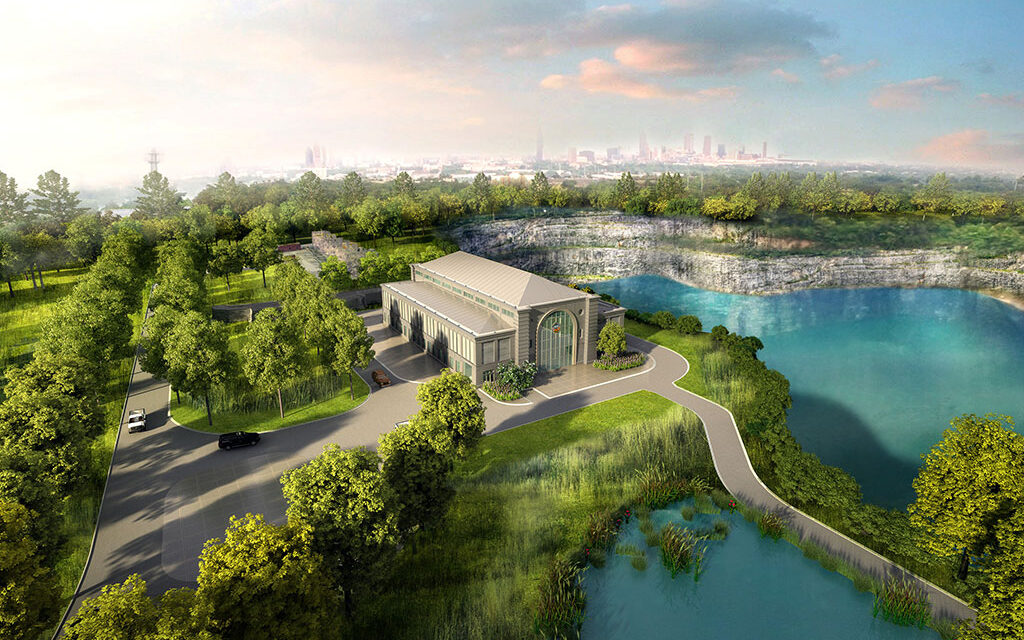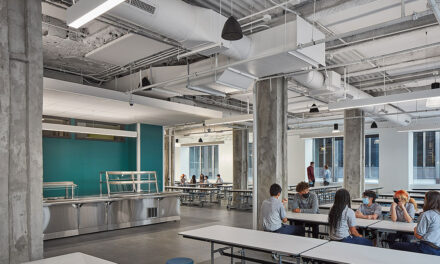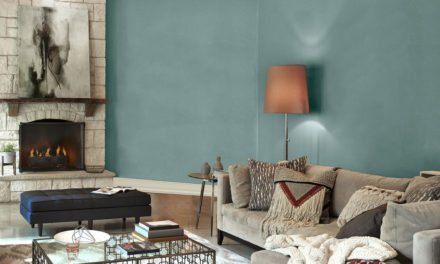The Bellwood Quarry, Atlanta’s iconic filming locale, awaits its closing scene as plans move forward for a transformation that will greatly impact residents. No longer will the mini canyon be featured as a Walking Dead zombie pit or a Stranger Things supernatural playground. Georgia’s landmark crater is now being filled with more than 2 billion gallons of water to create the state’s largest reservoir.
Although a cloak of nostalgia hangs over the quarry-to-reservoir conversion, city officials embraced the opportunity to increase the city’s water reserves from an insufficient five to seven-day supply to a 30-90-day surplus.
According to Atlanta’s Senior Watershed Director, Ade Abon, “The increase in raw water reserves will prove crucial if ever the city experiences a day without water from the Chattahoochee River—its only source—with an economic impact of $250 million a day. We need this.”
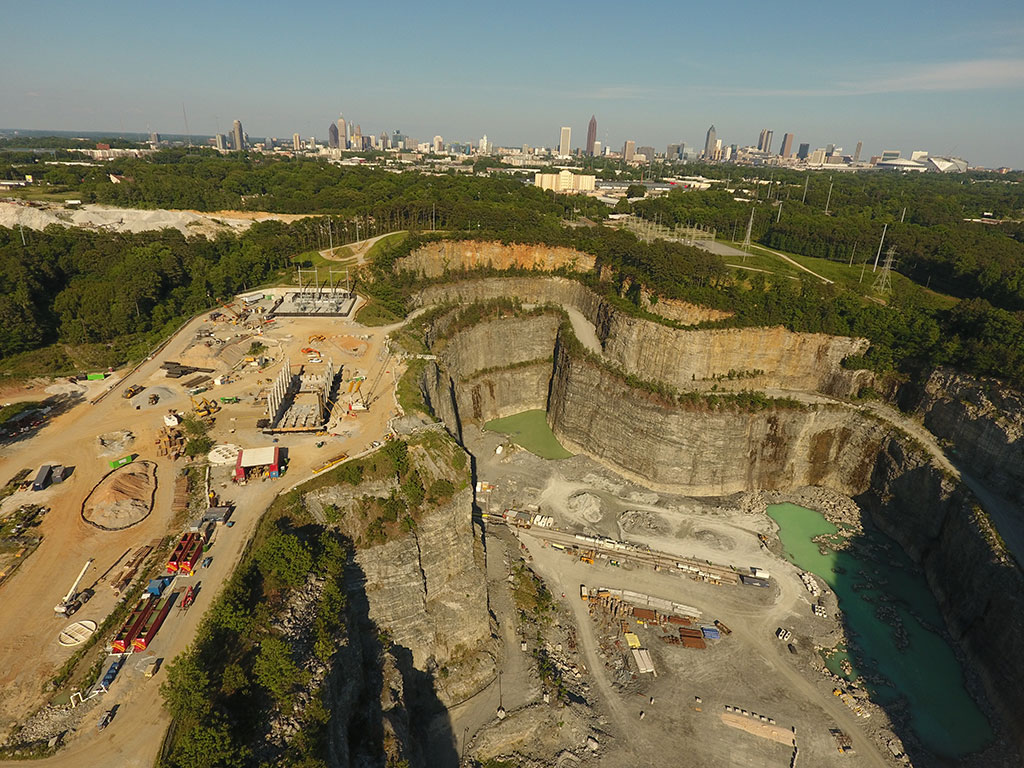
Best known for movie and TV scenes like “Stranger Things” and the “Walking Dead” the Bellwood Quarry will hold 2.4 billion gallons of water as a reservoir for Atlanta. Courtesy of PRAD Architects
This massive engineering feat began in 2018 when “Driller Mike,” a powerful boring machine was deployed to Atlanta to burrow a 10-foot diameter cylindrical passageway through five miles of Georgia clay connecting the Chattahoochee River with the Bellwood Quarry. Supervisor, Larry Weslowski, explained, “Once it was activated, “Driller” was on duty round-the-clock for almost a month before punching through the quarry wall last summer.”
Efforts then shifted to the painstaking process of coating the tubular interior surface with reinforced concrete and grouting. The resulting leak-proof, impermeable lining will contain the powerful sluice of river water.
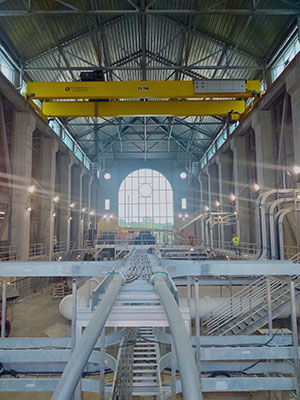
Architect Tom Steele turned the InsulTech 3-in-1 blocks around so the nicer exterior ground face was on the inside of the building, which is mainly un-air conditioned, providing a nice aesthetic for workers, minimal maintenance and providing maximum energy efficiency for the central electrical room and offices around the perimeter of the central space. Courtesy of PRAD Group
As the connective tunnel took shape, construction began on the quarry and treatment plant buildings, which were needed to house pump stations, office space, workshops, and electrical equipment. Although functional in nature, these structures will also blend into the Westside landscape.
Tom Steele, Senior architect and lead designer for the Atlanta-based PRAD Group, Inc., explained how Echelon’s InsulTech™ pre-assembled single-wythe insulated masonry units fit his distinct specifications for both structures. “Low-maintenance, cost-effective materials were a priority for both the Hemphill and Bellwood Quarry sites,” the architect noted.
He found Echelon’s labor-reducing and time-saving CMU system to be a superior choice compared to traditional multi-step insulated cavity walls. “It provided true continuous insulation, durability, and minimal maintenance we wanted to achieve, in a three-part system that resulted in dramatic savings,” Steele noted.
The system combines structural CMU, EPS foam insulation, air/water barrier and exterior veneer into a single 12 ¼-in unit, delivering above-code energy performance without sacrificing the masonry aesthetic.
For the Bellwood Quarry Pump Station, a large-scale multipurpose facility and future hub for reservoir personnel, the designer had to combine practicality and creativity. While utilitarian in purpose, the exterior called for an aesthetically pleasing look since it will serve as the anchor for future park expansion.
To create this appealing visual, Steele chose a native precast concrete finish, which will cast a beautiful reflection on the adjacent reservoir surface. In an innovative move, the designer flipped the InsulTech 3-part block, so the Trendstone™ in Sundown color faced inward, for an attractive, polished effect.
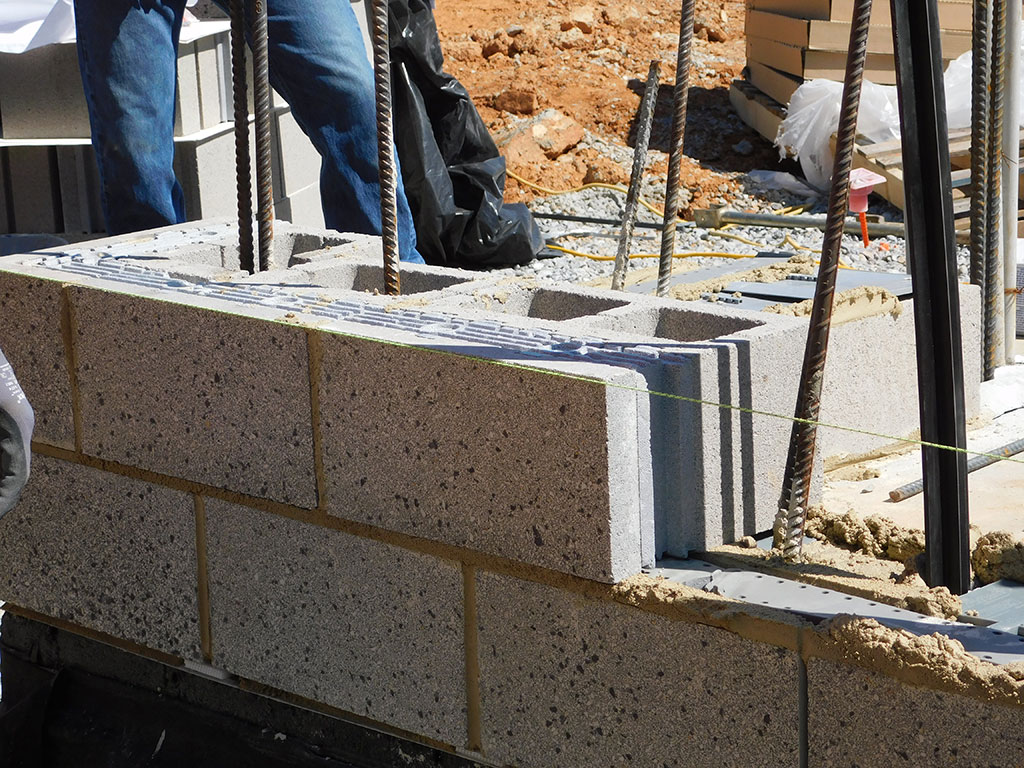
Echelon InsulTech wall system features a 3-in1 block that has built-in insulation to maintain temperatures and a ground face. In this case, the architect flipped the block so the nice aesthetic was inside the building, since the exterior was covered in precast concrete. Courtesy of Echelon Masonry
The structure’s focal-point entranceway—bookended by two soaring pilasters—forms a gateway for the striking arched-glass doorway. The designer’s overall vision resulted in a magnificent blend of form and function.
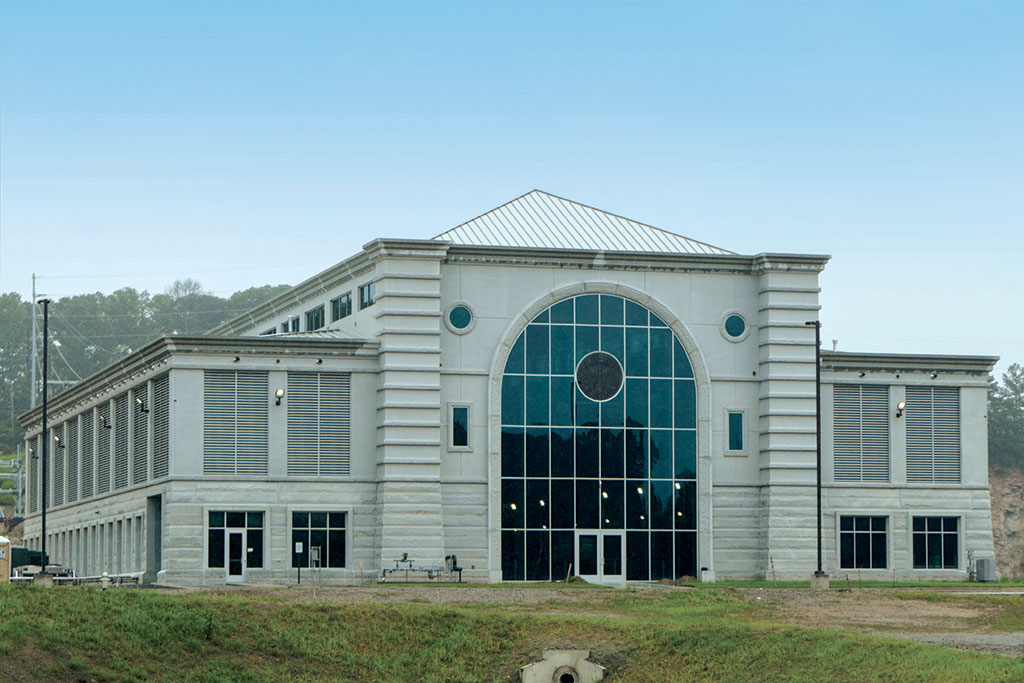
Courtesy of Echelon Masonry
“For the interior, it made sense to have hard surfaces that were insulated and had some thermal protection,” Steele explained. “Since the space where the pumps operate will not be climate controlled with year-round temperatures ranging from 55-100 degrees Fahrenheit. InsulTech was perfect for this.”
For the nearby Hemphill Water Treatment Plant site, Steele created a workshop with 12’ walls and an electrical facility with 18’ high walls again using the InsulTech system.
While smaller in scale, this part of the project plant required some complex coordination by masons. Drew Lamberson, project manager/estimator with Bibler Masonry Contractors, Inc. explained the situation. “This was the first time InsulTech was used in Georgia, so we all benefitted from some training with the system,” said Lamberson. As it routinely does, Echelon provided in-person assistance throughout the build to help streamline installation of the innovative – if unfamiliar – design.
On the Hemphill site, space constraints, two different wall heights, and three different façade veneer colors made it challenging for his team to lay out configurations on the ground. The contractor recalled, “Len Browning and his technical team really made the difference. His diagrams showed exactly how many blocks of each color went where.”
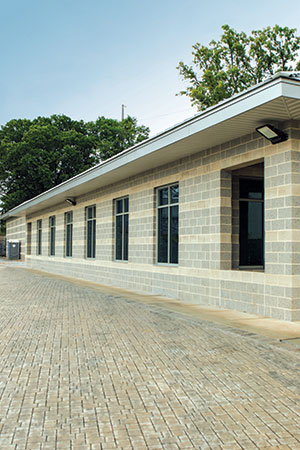
Courtesy of Belgard
Since these buildings will be visible to the public, Steele selected Trendstone and Mesastone architectural units—prefinished, integrally colored concrete blocks—as the outer faces for the InsulTech system. The units are manufactured with one or more faces ground to expose the variegated colors of the natural aggregates. A pre-applied clear satin gloss acrylic enhances moisture resistance and adds a glossy finish.
With the Westside area predicted to undergo widespread development, Steele found architectural trends somewhat difficult to predict. To blend in with the area’s mixed-style architecture, he fashioned a simple cost-efficient design with a little extra pizzazz for up-close viewing.
The resulting pattern alternated between Trendstone and Trendstone Plus, both in Haydite color. The “Plus” version delivers a smooth terrazzo finish, which added a glittering effect to the exposed wall—with Mesastone textured CMUs in Sedalia color as a light-colored accent strip.
“It has a little more flair than a typical industrial building yet is still something that will stand for a long time and not need maintenance,” explained the architect. Echelon’s comprehensive masonry offerings enabled Steele to strike the perfect balance.
He added, “If you see the buildings up close, you’re pleasantly surprised by the pattern you might find in the wall. The InsulTech with the Trendstone and Mesastone finishes give them a nice feel. We want folks to know municipal funds are going toward something nice, especially since these are enduring structures.”
And the highly durable and easy-to-clean surface made it an ideal choice for this graffiti prone area. “With the sealant that’s integrated into the block face at the factory, that shouldn’t be a problem to clean, if it should occur,” assured Steele.
In the past, The PRAD Group has worked with the Atlanta Watershed Department on several projects to ensure that the city’s increased pavement areas get retrofitted with optimal storm water drainage solutions.
For the Hemphill accessway, Steele explained, “We chose Belgard’s Aqualine ™ 9L Permeable Paver, a 9X9 inch profile, because the L-shaped paver fit the area well.” The same Permeable Interlocking Concrete Pavers (PICPs) had been installed in a nearby Atlanta neighborhood, distinguishing it as the largest PICP retrofit project in North America. “It also had the benefits of LEED points and drainage properties, as well as its ability to stand up to the regular heavy truck traffic. Aqualine 9L helps to keep the water on the site just long enough to actually seep back into the earth and prevent run-off,” added Steele.
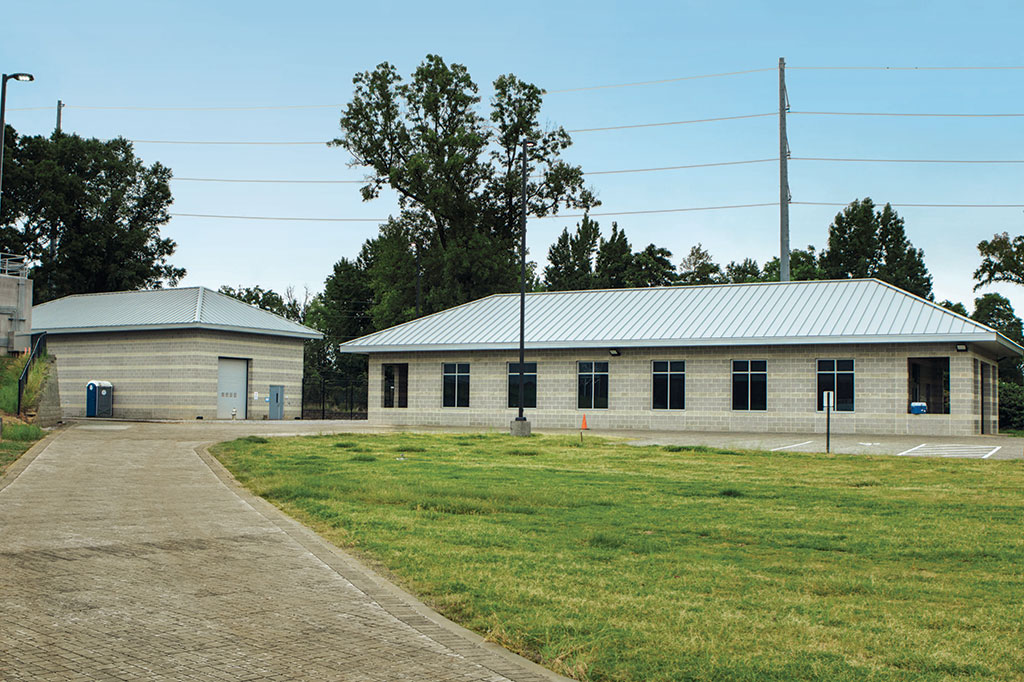
Belgard Aqualine Pavers in cream/grey were used for the electrical building parking area (adjacent to large Pump Station building), which Ade Abon, the Watershed Director says has worked very well in absorbing water runoff from record rainfalls in early spring. Courtesy of Belgard
While Atlanta recorded record-breaking downpours this past winter, the Aqualine pavers kept the Hemphill accessway puddle-free. After inspecting the area, Watershed Director Abon confirmed, “The pavers look great and have held up well.”
With tunnel construction nearing completion, he and his colleagues look forward to the much-anticipated filing of the quarry, the capstone to this ambitious phase of the project. He reflected on progress so far. “After the inner coating was completed, a purging of debris was necessary to remove any construction by-products.”
Other recently completed aspects of the initial phase included placement of a permanent plug at the entry point to hold back the forces of the Chattahoochee River. In addition, two slow-control shaft systems at entry and exit points were installed to regulate water flow between the river and the basin.
Once the reservoir is filled, reserves can then be channeled as needed to the nearby Hemphill Water Treatment Plant. Abon estimated the length of time to fill the gorge at five to six months. However, several variables will come into play including customer need, treatment plant capacity, and Mother Nature. “The underground work was completed at the end of March 2020, and the raw water release began in mid-April 2020.” The water flowing into the new emergency reservoir will eventually hold 2.4 billion gallons of water. This milestone event marks the completion of Phase I of Atlanta’s large-scale Westside overhaul. Although the Bellwood Reservoir is too small for recreational use, the ripple effects from this transformational endeavor will be felt throughout the City of Atlanta.
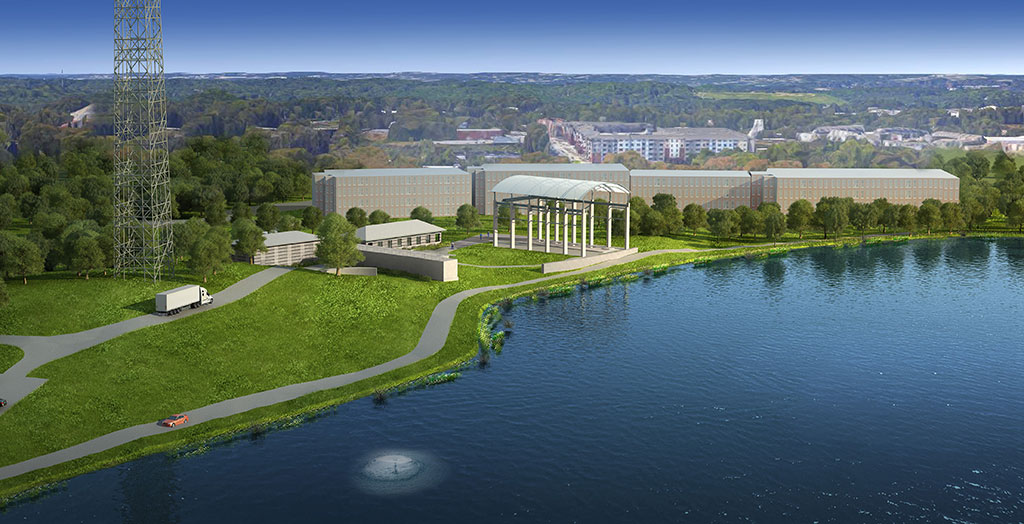
Courtesy of PRAD Group
Phase II of the multi-phased effort is scheduled to break ground this summer, as planners begin to shape the contours for Westside Park, a 280-acre multi-use recreational space predicted to attract droves of developers. With an injection of public and private funding, change is inevitable for the landscape of Atlanta’s long-neglected West Side. Park trails are configured to connect with the Atlanta BeltLine—a pedestrian/bike pathway designed to eventually loop around the entire metro area making the area even more accessible to Westside commuters. Such forward-thinking vision allows Atlanta to continue its reign as The Empire of the South.
Learn more at www.EchelonMasonry.com or www.Belgard.com
About Echelon Masonry
Echelon Masonry is North America’s largest manufacturer of the highest-quality masonry products for the architectural and masonry industries. As the consolidated masonry brand for Oldcastle APG, a CRH Company, Echelon offers the widest masonry portfolio in the industry, from trusted brands like Trenwyth to innovative product solutions like the InsulTech System, as well as the localized, one-on-one support needed to bring the most ambitious projects to life.
Since 2015, Echelon Masonry has been committed to supporting the time-honored tradition of masonry and advancing the craft for the 21st century and beyond. www.EchelonMasonry.com
About Belgard®
Belgard, part of Oldcastle APG, a CRH Company, offers a complete collection of paver and wall products for outdoor living spaces, walkways, driveways, parking areas and retaining walls. Available in a range of styles, premium Belgard products have been found in America’s finest homes and award-winning commercial and retail properties since 1995. For more information, visit Belgard.com or call 1-877-Belgard (235-4273).

